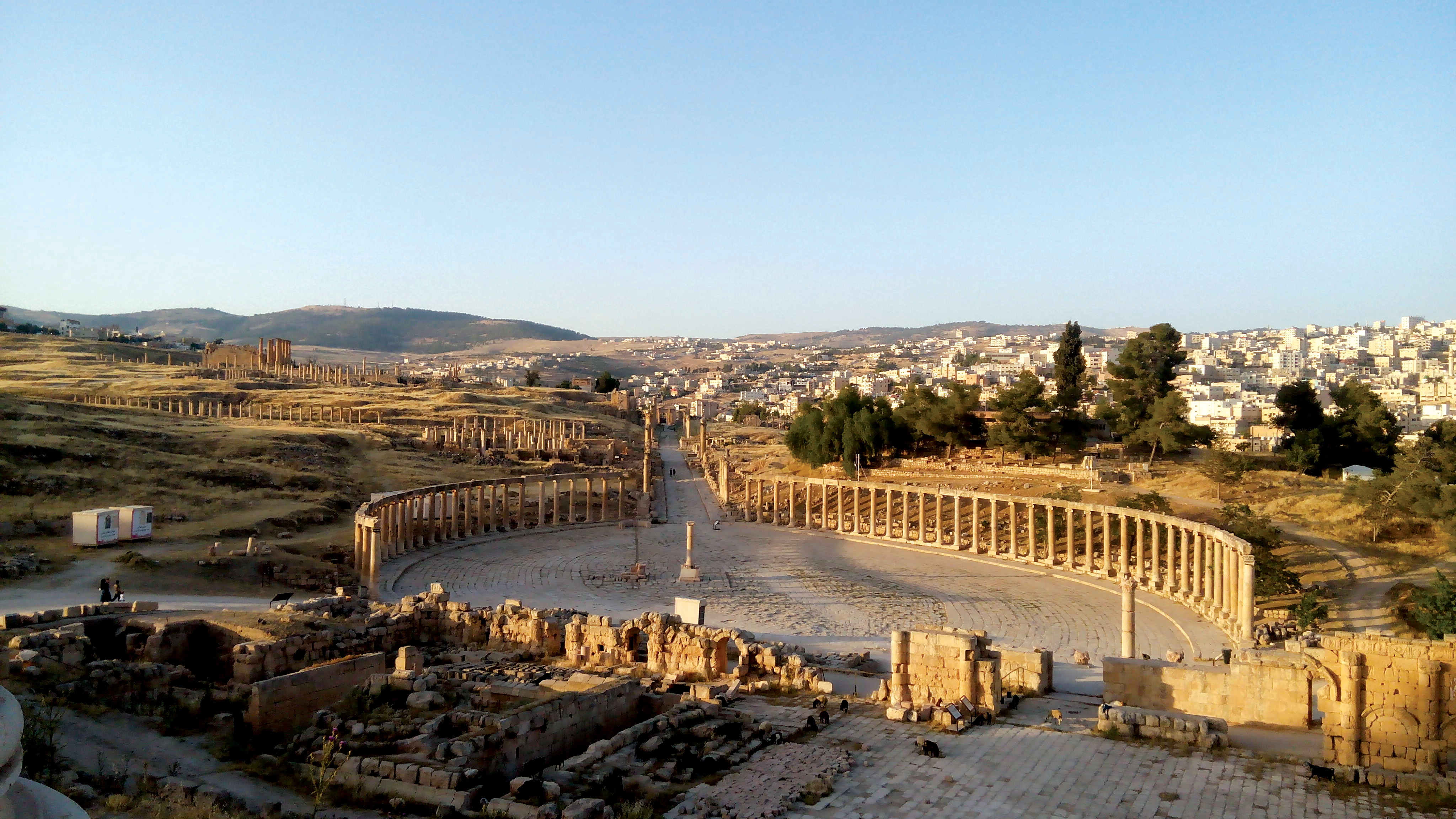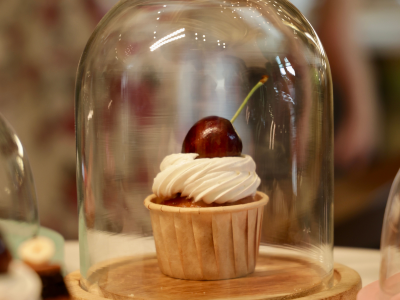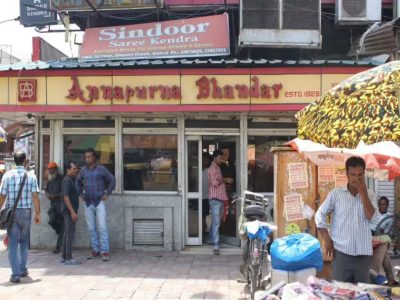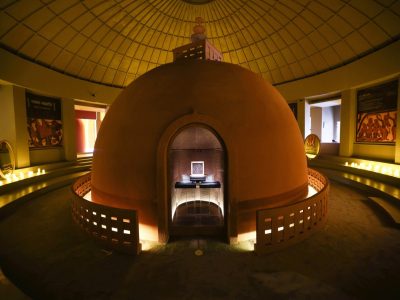Inhabited since the Neolithic Age, the World Heritage Site of Petra, Jerash, Mount Nebo and Wadi Rum in Jordan offer powerful lessons in history
The only thing that remains constant in Jordan is the cat—the little blue-eyed cat strutting everywhere. This brave little creature lives like a nomad, even as tourists come and go. I haven’t heard of even one unpleasant incident related to the little nomad.
All nights are starry here for the clear sky beams while we gaze upon the natural wonders. But this night is even more starry as I am walking the two-km stretch from the road to the famed treasury of Petra—a UNESCO World Heritage Site and an explorer’s treasure trove. The night camouflages the exotic red hills. The tombs remain silent. The dead probably wonder why humans are invading their home so late. But the path lit by tiny lamps sitting in sand, makes this walk so adventurous.
The famous treasury in the world is ready to share its secret. The narrow canyon path is full of excited whispers. And then the treasury stands before me. I find a place on the floor, lamps flicker and a cat brushes past my feet, scaring me.
Some call it the rose city, others an erstwhile traders’ market, yet others know it as a place where rest the souls of many Nabateans. Petra has floored generations since its discovery in 1812 by Swiss explorer Johann Ludwig Burckhardt.
The flute casts a magical spell and with eyes closed, it doesn’t seem like Earth anymore. Then the tales of the Bedouins come alive. The cats are all ears too. For a few minutes, the treasury changes colours — from red to orange to blue and green and the flute seems to weave itself into these coloured waves. Sipping the small cup of Arabic tea, I could have been on Mars. All too soon, the story ends, the music stops and the silent heart walks out of this amazing city.
It is the day that reveals more. I come to see the city in full light the next morning. The sun appears strong, but the landscape is fascinating. There is the option of taking a horse cart, but a walk through the tombs of the rich and the famous is so surreal. There are rocks and more rocks, red rocks and tombs. Some look like elephants, some just lumps, most natural rocks seem to have funny shapes.
I peek into some caves, some big ones are off-limits. The bigger the cave, the more famous the man. Most families are also buried in the same zone and occupy a bigger area. And then I walk ahead to meet the gods residing in the narrow path leading to the treasury. Craning my neck, I see clearest blue sky through the narrow opening. Some shrubs and flowers have dared to grow in the barren crevices, adding a tad bit of colour to the red sandstone hills. I gaze at the stone where marriages have taken place. The ancients are probably watching, maybe some couple would spring out of the stones. I hurriedly go forward.
Like Indiana Jones, after many twists and turns, the path opens right in front of the treasury. The magnificent red stone carving stands before me in full glory. With three rooms, a calendar, mythological figures and an urn, this is perhaps the most exhilarating experience of my life.
The city’s marvels leave me awestruck. There is a monastery, more tombs and an amphitheatre too. I need an hour to reach the monastery which is a spectacular one, I am told. No trendy roads or stalls, just a stack landscape and natural shapes and impressions of nature. As the wind rustles through my hair, I watch the grazing sheep, tourists climbing to see more tombs to take back more experiences.
And then donkeys, camels and souvenir sellers break the spell. The area is inhabited by Bedouins whom the government has been rehabilitating into urban life. They now trade souvenirs and have small cafes here. There is even a bookshop run by Marguerite van Geldermalsen. This New Zealand-born nurse married Mohammad Abdallah Othman, a Bedouin souvenir-seller from Petra in 1978 and wrote the book ‘Married to a Bedouin’. She sits there and you can buy a signed copy and hear her tale live! I sip a glass of fresh orange juice in the scorching sun. There are donkeys, camels and horse carts here. Walking back slowly, the red hills are an unforgettable experience.
The journey doesn’t end at Petra; there is a Little Petra also to be seen. Just a short distance from Petra, we drive through the magnificent landscape. While Little Petra is the common name, it’s called Siq-al-Barid which means ‘cold canyon’. The high walls and narrow canyon path make it difficult for the sunlight to penetrate fully, hence the name.
The first thing that catches the eyes is the starkness. There are patches of grass though where the sheep were grazing. A signboard says ‘Neolithic Village 8500-5500 BC’. I am in another world, an unimaginable world. Walking through the narrow path into the realms of the Nabateans, Little Petra has a room of records. This is where traders visiting the area would register before proceeding ahead. The narrow canyon path actually leads into Petra but has been closed off due to safety reasons. As I crane my neck through the crevices and up into the high walls, I wonder what the Nabateans were like. No answer, only some openings carved into the walls gaze back. There is a dining hall with some frescoes but the steps are broken and I stay put. As the sun goes down, the landscape bursts into shades of reds. It is time to head back.
Explore more
Jordan takes you back to the beginning. From the citadel of Amman to the columns of Jerash, this little country houses many compelling spots. Jerash, called the Pompeii of the East or the city of 1000 columns, brings alive the Greco Roman era. Evidence suggests that Alexander the Great lay the roots for this city.
On one side is the temple of Zeus, on the other side you can feel the thundering Roman warriors, imagine the Ottoman trading and see rows of olive trees. It is also the birthplace of mathematician Nicomachus of Gerasa (c. 60 – c. 120 AD). The South Theatre is ringing with traditional music. The tourists are listening but I gaze at the sheep and the shepherds. The old and the new, the ancient and the modern, the beauty of co-existence—this is Jordan.
Floating in the Dead Sea is a must when in Jordan for this is the lowest point on Earth. A sea which is loaded with minerals, this is one place where you can’t let the water into your eyes. Just lie back, read a book and float back to the shore in time or you could find yourself on the other side in Israel.
The country is home to many biblical sites also. Bethany is where the mosaic highlighting the baptism of Jesus was excavated. It shares a small stream with Israel where you can sip some holy water and dip in it too. Then there is Madaba where the oldest mosaic map of the Holy Land can be seen in a Greek Orthodox Church. Do go to Mount Nebo for this is where Moses sighted the Promised Land and a view on a clear day is among the many marvels of this country. The Brazen Serpent monument is the most striking feature here.
For the modern ones, there’s the coastal town of Aqaba with water sports, desert safari in Wadi Rum (where The Martian was shot), and nightlife at Rainbow street in capital Amman.
Planning a trip
Best time to go September to March.
Most monuments are ticketed.
Currency: 1 Jordanian Dinar (JOD) = Rs 96.75





